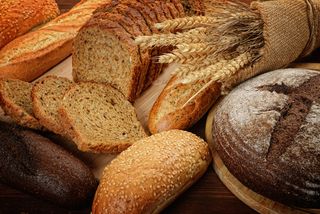Facts About Whole Grains

For many years, breads and pastas got a bad rap for being full of carbs. Many people, while trying to make their diets healthier, cut these items from their diet. Recently, breads and pastas are becoming popular again, but only when the label says they contain "whole grains."
This label can be confusing, though, since many products label themselves as whole grain, when the product doesn't contain very much whole grain at all.
Definition
According to the Food and Drug Administration (FDA), a product should contain intact, ground, cracked or flaked cereal grains that still contain their endosperm, germ and bran to be considered whole grain. Cereal grains include wheat, buckwheat, bulgur, corn amaranth, barley, millet, teff, triticale, quinoa, rice, rye, oats, sorghum and wild rice.
The endosperm, germ and bran are the main anatomical components of a cereal grain. Including these parts in a food is including the whole grain, thus the name "whole grain" on products.
A groat is a hulled grain that has been broken into fragments. The groat still includes the main anatomical components of a cereal grain, though, even though it has been hulled.
While the FDA provides these guidelines, manufacturers are often loose with their labeling of whole grains. Some products label themselves as whole grain, but only contain some whole grain ingredients. The FDA recommends looking for products that are labeled as "100 percent whole grain" instead of "whole grain" to get the most whole grain content. The Whole Grains Council recommends taking a look at the nutrition label. If the first ingredient is listed as a whole grain, the product is more likely to contain more whole grain.
While some whole grains are high in fiber, not all are. So, looking at the fiber content in a product isn't always a good indication of the whole grain content.
Nutritional information & benefits
The American Heart Association recommends eating six to eight servings of grain foods, especially whole grains, per day. Whole grains are important for the body for a number of reasons.
For example, whole grains are rich in the mineral magnesium. Magnesium is used by over 300 enzyme systems in the human body, according to the National Institutes of Health. It is vital for heart health, brain health and bone health.
This is the magnesium content of several different whole grain cereals per 200 calorie serving, according to Dr. Carolyn Dean, a nutrition expert who specializes in health, aging and diet:
- Wheat bran, crude: 566mg
- Rice bran, crude: 494mg
- Oat bran, cooked: 200mg
- Oat bran, raw: 191mg
- Rye flour, dark: 153mg
- Buckwheat flour, whole-groat: 150mg
- Buckwheat: 135mg
Though many people avoid pasta and breads to avoid carbs, they should rethink whole grain versions of these foods. "People who only look at carbs and don't look at whole grains vs. processed grains do not fully understand the health benefits of whole grains," said Dr. Dana S. Simpler, an internist with a special interest in nutrition. While whole grains and processed grains have equal amounts of carbohydrates, they do not have the same effect on metabolism and blood sugar. "Whole grains are slowly absorbed and gradually metabolized, while processed grain flours are quickly absorbed leading to spikes in insulin and blood sugar," Simpler said.
Dr. Adrienne Youdim, an associate professor of medicine at UCLA David Geffen School of Medicine and an assistant professor of medicine at Cedars-Sinai Medical Center, agrees that whole grains are an important part of a healthy diet. "Whole grains, including breads, cereals and pastas have been shown in scientific studies to reduce heart disease and heart disease related deaths, when taken as a part of a heart healthy diet. Not all carbs are the same. Not all carbs are bad!"
A recent study found that people who ate at least three servings of whole grains daily were 20 percent less likely to die early when compared with people who ate less than one serving a day. Eating three servings a day of whole grains was also associated with a 14 percent lower risk of death from cancer and a 25 percent lower risk of death from heart disease, according to the study.
Whole grains can also be good for your eyes. According to the California Optometric Association, whole grain's low glycemic index can help reduce the risk for age-related macular degeneration, which is the leading cause of severe vision loss in people over the age of 60. Also, vitamin E, zinc and niacin are found in whole grains, which can help promote overall eye health.
Whole grains can be an important part of a weight-loss program, as well. They can make a person feel fuller, so they eat less, according to the American Heart Association. This can lead to weight loss.
Risks
When making the switch to whole grains, you may become deficient in folic acid, a B vitamin, according to the Mayo Clinic. Often, more processed foods are fortified with folic acid, while whole grain breads are not. Be sure to take a look at the nutrition facts on the back of products to ensure they contain folic acid.
Additional resources
Sign up for the Live Science daily newsletter now
Get the world’s most fascinating discoveries delivered straight to your inbox.
